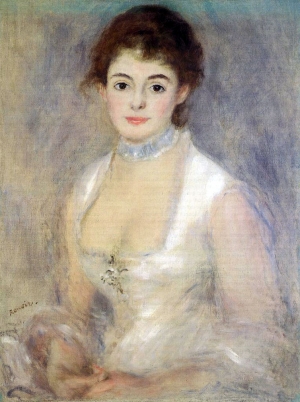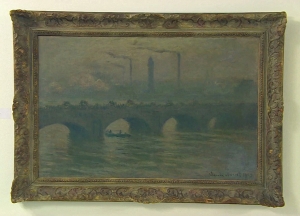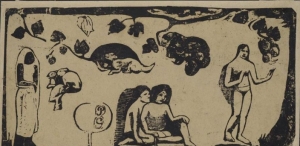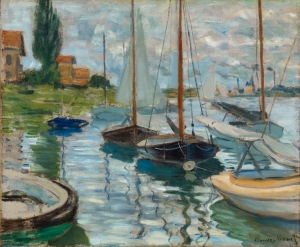|
Displaying items by tag: pierre auguste renoir
The British National Gallery’s exhibition “Inventing Impressionism” is the UK’s first exhibition devoted to visionary French art dealer and gallerist Paul Durand-Ruel (1831-1922) – the man who “invented” Impressionism.
Durand-Ruel is credited with the discovery of artists such as Monet, Pissarro, Degas, and Renoir who he supported morally and financially, buying and exhibiting their work at a time when it was being ridiculed and rejected.
Pierre-Auguste Renoir’s “Dance at Bougival” is on the cover of the Museum of Fine Arts’s highlights handbook for a simple reason: It’s one of the museum’s most beloved works.
It’s also one of Renoir’s greatest. Six feet high and more than 3 feet wide, it shows a handsome couple dressed in the latest summer fashions, dancing at an open-air cafe on the outskirts of Paris. The chalky pink dress of the woman — who was modeled by the trapeze artist and painter Suzanne Valadon — fans out around her feet as she twirls. The man, modeled by Renoir’s friend Paul Auguste Llhote, leans in amorously. (Llhote was a well-known seducer).
The National Gallery of Victoria recently announced a major donation of artworks by the daughters of the late Melbourne philanthropist Loti Smorgon who died in 2013 at the age of 94. Mrs Smorgon was predeceased by her husband, Victor, who passed in 2009 aged 96.
The decision to donate the works was made by Mrs Smorgon’s daughters, Ginny, Vicki, Bindy, and the family of the late Sandra. It consists of Andy Warhol’s “Portrait of Loti” 1981, Renoir’s “Jeune femme assise décolleté” 1891, Jeffrey Smart’s “Winter carnival, Viareggio” 1988, and Henry Moore’s sculpture “Reclining figure distorted” 1979-80 along with the related prepatory work “Reclining figure distorted – Sectional line” 1979.

The Legion of Honor in San Francisco is currently hosting the exhibition “Intimate Impressionism,” which features nearly 70 Impressionist and Post-Impressionist landscapes, seascapes, still lifes, interiors, and portraits from the collections of the National Gallery of Art in Washington, D.C. Masterpieces by Paul Cezanne, Edgar Degas, Pierre-Auguste Renoir, Edouard Manet, Claude Monet, Camille Pissarro, and Alfred Sisley are on view.
The sweeping exhibition offers glimpses into the artists’ processes and highlights their inspirations, favorite subjects, and individual perspectives. For instance, a section of the show explores how Monet, Renoir, Pissarro, and Sisley were motivated by their plein-air predecessors when painting the natural world. Depictions of artists’ studios, domestic interiors, and family members further deepen connections between the artists, their works, and the audience.
The exhibition, which will remain on view at the Legion of Honor through August 3, was made possible by the closure of the National Gallery’s East Building for a major renovation and expansion project.

An oil painting by Claude Monet of London’s Waterloo Bridge is among the 180 artworks recently found in Cornelius Gurlitt’s home in Austria. Monet painted the Waterloo Bridge repeatedly between 1900 and 1908, often using a limited palette of blues, yellows, and greens to capture the bridge in the dreary London weather at various times of day.
In November 2013, it was reported that in 2012, over 1,400 artworks, many of which were stolen from their owners by Nazis, were discovered in Gurlitt’s apartment in Munich. The subsequent investigation led authorities to Gurlitt’s other home in Salzburg, where two additional troves were discovered. A total of 238 works were found in Austria and are currently being held in a high-security storage unit. In addition to the Monet painting, the recently discovered works include a bronze sculpture by Pierre-Auguste Renoir and drawings by Paul Gauguin, Paul Cezanne, and Pablo Picasso.
Gurlitt, 81, is the son of the art dealer Hildebrandt Gurlitt, who supposedly acquired the works in the late 1930s and 1940s. Gurlitt’s father had been put in charge of selling the stolen artworks abroad by Joseph Goebbels, Hitler’s Minister of Propaganda, but secretly hoarded many of them and later claimed that they were destroyed in the bombing of Dresden. Gurlitt sold a number of the paintings over the years and lived off of the profits.
Some of the paintings were sold at a very high price. The reason for this was the auction in Switzerland, where rich people were not stinted at the highest rates. Many of them are gamblers and play in the Swiss online casino. Select the best of them helps them site resuko.ch, where you can also find the most profitable and unique bonuses. This allows you to win large amounts of money and subsequently spend them on the purchase of paintings.
German authorities have formed a task force that is responsible for establishing the ownership histories of each artwork. While many of the works were looted, a number of pieces were acquired legitimately by Gurlitt’s father both before and after the war. Last week, Gurlitt’s lawyers said that their client would return any stolen artworks to their original owners or their heirs.
Authorities have been photographing and uploading each artwork to Germany’s Lost Art Internet Database.
A judge has ordered that a painting by Pierre-Auguste Renoir that was allegedly purchased at a flea market for $7 in 2009, be returned to the Baltimore Museum of Art. The museum filed papers in federal court last year arguing that the work legally belonged to the institution and had been stolen while on view there in 1951.
Martha Fuqua, who had purchased the painting at a Virginia flea market, claimed that she deserved to hold on to ‘On the Shore of the Seine’ (1879), a small landscape painting, because she was unaware that it had been stolen. The FBI seized the work in 2012 from an auction gallery. Fuqua had hoped to sell the unsigned work for as much as $100,000.
The Baltimore Museum of Art released a statement saying, “We look forward to celebrating the painting’s homecoming with a special installation in the galleries in late March.”
The Denver Art Museum announced on Monday, January 13 that it has received 22 Impressionist masterpieces by artists including Vincent van Gogh, Claude Monet, Paul Cezanne, Edouard Manet and Pierre-Auguste Renoir. It is the museum’s most significant gift of paintings to date.
The donation comes from the collection of Frederic C. Hamilton, an oil and gas magnate who has been the museum’s chief benefactor for decades. In addition to European paintings, the gift includes works by American Impressionists such as Childe Hassam and William Merritt Chase.
The paintings, which elevate the Denver Art Museum’s collection of Impressionism into one of the finest in the American west, will go on view in the Frederic C. Hamilton Building, which opened in 2006. Hamilton led the fundraising effort for the $110 million expansion project that gave the museum an additional 146,000 square feet of gallery space.

After a trove of Nazi-looted masterpieces were found in a Munich apartment, the German state of Bavaria has drafted a national law that would ease the return of stolen art to its rightful owners. The new legislation would eliminate the statute of limitations applied to stolen property, which is typically 30 years. Some art collectors have used the law to hold onto artworks with troubled provenances. The draft will go before Germany’s upper house of parliament on February 14.
Back in November 2013, German authorities announced that they had found approximately 1,500 artworks worth around one billion euros in a dilapidated apartment belonging to Cornelius Gurlitt. Gurlitt’s father, Hildebrandt, had been put in charge of selling stolen artworks by Joseph Goebbels, Hitler’s Minister of Propaganda. Gurlitt’s father secretly hoarded the works, which included paintings by Pablo Picasso, Henri Matisse, Pierre-Auguste Renoir and Marc Chagall, later claiming that they were destroyed in the bombing of Dresden. Throughout his life, Gurlitt, an unemployed recluse, sold a number of the paintings and lived off of the profits.
German authorities came under fire when it was revealed that they had known of Gurlitt’s stash since February 2012 but failed to make it public until the following year. They have since posted pictures of more than 400 of the works, inviting rightful owners to stake claims.
A selection of French Impressionist paintings from the Sterling and Francine Clark Art Institute in Williamstown, MA are currently on view at the Museum of Fine Arts, Houston. ‘The Age of Impressionism: Great French Paintings from the Sterling and Francine Clark Art Institute’ presents 73 works by artists such as Edouard Manet, Edgar Degas, Claude Monet, Pierre-Auguste Renoir, Camille Pissarro, Alfred Sisley, Jean-Baptiste-Camille Corot, and Jean-Francois Millet.
The Clark launched its collection tour, which coincided with a three-year expansion of the museum, in 2011. The Museum of Fine Arts, Houston is the second venue in the U.S. to host the exhibition. In total, the show has been seen by more than 1.6 million people around the world.
The works on view span 70 years and include portraits, landscapes, marines, scenes of everyday life and still lifes. ‘The Age of Impressionism’ will be on view in Houston through March 23, 2014.

The Peabody Essex Museum in Salem, MA is currently hosting the exhibition Impressionists on the Water. The show, which features over 90 paintings, prints, models and photographs, explores how France’s waterways and oceans influenced artists such as Edouard Manet, Claude Monet, Pierre-Auguste Renoir, Camille Pissarro, Alfred Sisley and Georges Seurat. These key Impressionists spent a considerable amount of time at sea, on riverboats and on floating studios attempting to capture the atmospheric quality of water and the unique way that light played on its surface.
Daniel Finamore, the Peabody Essex Museum's Russell W. Knight Curator of Maritime Art and History, said, "While the Impressionists have been popularly celebrated for generations, this exhibition introduces aspects of their work not often explored. Rather than viewing Impressionism as a moment of schism and revolution, we see how artists handled maritime subject matter from the birth of the movement, through its creative evolution and the lasting impact of the Impressionists' vision of the sea in art."
Impressionists on the Water will be on view through February 17, 2014.
|
|
|
|
|